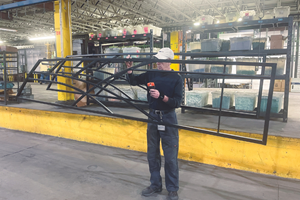Corrosion Resistance Testing for Powder Coating
Salt spray can be useful to help compare different pretreatment methods and coatings but it does not tell us much about the corrosion resistance of a part over time in the field. Powder coating expert Rodger Talbert offers insights into how to get a better idea of how to improve a part’s corrosion resistance in the real world.

Rodger Talbert has more than 30 years of experience in the powder coating industry.
Q: We have begun to take on some automotive components that fit under the dash, inside the car interior and under the hood. The appearance standards are not too hard for us to achieve but we are a little concerned about the corrosion requirements. Some of them are just 500 hours of neutral salt spray, but some are 1,000 hours and that may be more challenging. We are able to pass the salt spray test but we have had some field failures (rust). The rust occurs on edges usually but it can also occur in corners and sometimes on the flat areas of the part. We use a five-stage iron phosphate wash process. Some of the parts require a hybrid powder and a few have some UV requirements that we use a TGIC powder coating material to meet. Any suggestions on how we can better ensure corrosion resistance would be appreciated.
A: While salt spray has been used for many years by the automotive industry as a standard the salt spray results and field performance are not closely connected. Salt spray can be useful to help compare different pretreatment methods and coatings but it does not tell us much about the corrosion resistance of a part over time in the field.
Using salt spray to qualify a process is ok if you can verify it regularly to confirm the reliability of the process. If you pass a certain level of salt spray one day and do not pass on another day, there may be something that is not working properly and needs to be brought back into a safe range. In testing, remember to always use a control panel from a test facility to ensure the problem is not related to your steel material. A polished ACT or Q panel should always be part of your testing. Run at least three panels or parts to establish reliability.
Iron phosphate does not add much to the corrosion resistance. I would suggest you consider a zirconium oxide or zinc phosphate to improve performance. The zirconium oxide will improve corrosion resistance and does not have the environmental challenges of a zinc phosphate. Before you do the chemical treatment, be sure you have clean weld areas and round the sharp edges if you can. The chemical pretreatment will not remove weld smut and you need better edge coverage based on your description. You can grind or blast those inorganic soils and you will get better performance. You should also consider a powder primer coat. The primer will add a lot of corrosion protection. It will also help to round those edges and give you more coating at critical locations. A double coat of powder is always superior for edge coverage and corrosion protection.
For reliable testing of corrosion, you should consider a cyclic corrosion test. Putting a part through wet/dry cycles will provide a better correlation to exposure in the real world. Different specifications exist or can be created as to the specific cycles to use for a given industrial application. If you are doing automotive work, your customer can provide you with the right specification. SAE J156315 is a good source for guidance on cyclic testing. Do the testing routinely and use the results for the development of reliable control ranges for your pretreatment process and application.
Related Content
Online Energy Savings Calculator Promotes Energy Efficiency
An online energy savings calculator from AkzoNobel aims to help customers determine how to reduce energy usage.
Read MoreMastering Uniformity Through Surface Prep Standardization
By standardizing surface preparation processes and adopting surface energy measurement, a company can achieve uniformity, quality and cost reduction.
Read MoreNASF/AESF Foundation Research Project #121: Development of a Sustainability Metrics System and a Technical Solution Method for Sustainable Metal Finishing - 12th Quarterly Report
This NASF-AESF Foundation research project report covers the twelfth quarter of project work (January-March 2023) at Wayne State University in Detroit. In this period, our main effort concentrated on documenting technical content that was yet to be reported, including analysis of costs for specific technologies for sustainability improvement.
Read MorePowder Coating Overcomes Post Forming
Six Sigma methodology, open communication, and collaboration produce results for leading boat manufacturer.
Read MoreRead Next
Episode 45: An Interview with Chandler Mancuso, MacDermid Envio Solutions
Chandler Mancuso, technical director with MacDermid Envio discusses updating your wastewater treatment system and implementing materials recycling solutions to increase efficiencies, control costs and reduce environmental impact.
Read MoreDelivering Increased Benefits to Greenhouse Films
Baystar's Borstar technology is helping customers deliver better, more reliable production methods to greenhouse agriculture.
Read MoreEducation Bringing Cleaning to Machining
Debuting new speakers and cleaning technology content during this half-day workshop co-located with IMTS 2024.
Read More






















